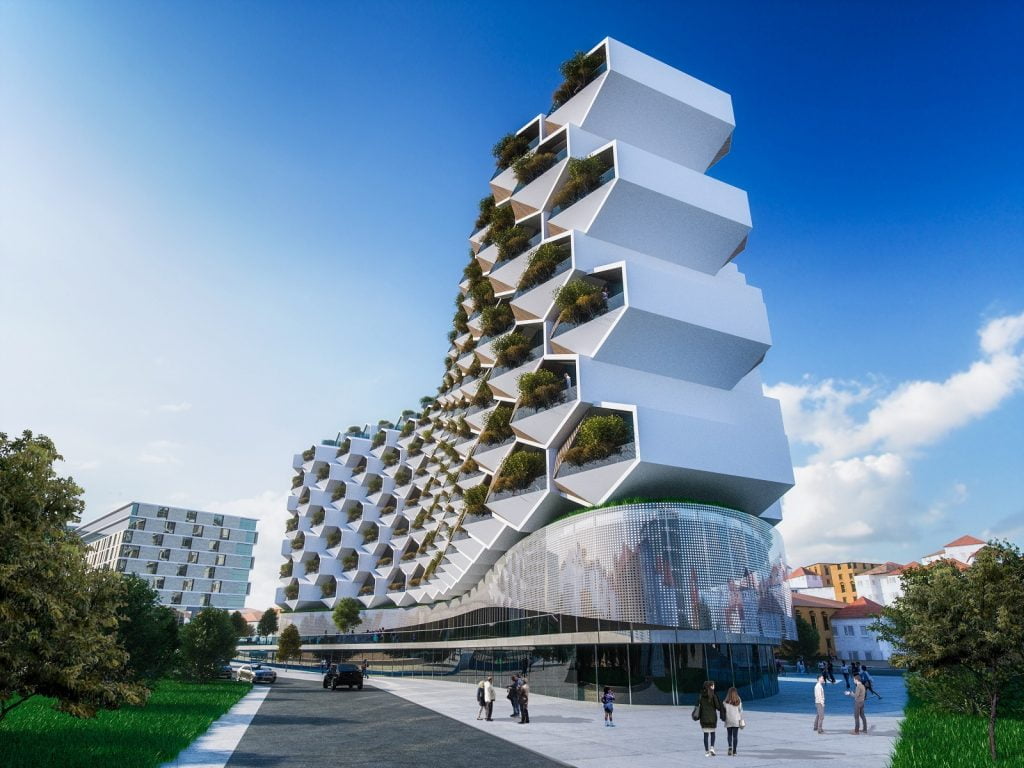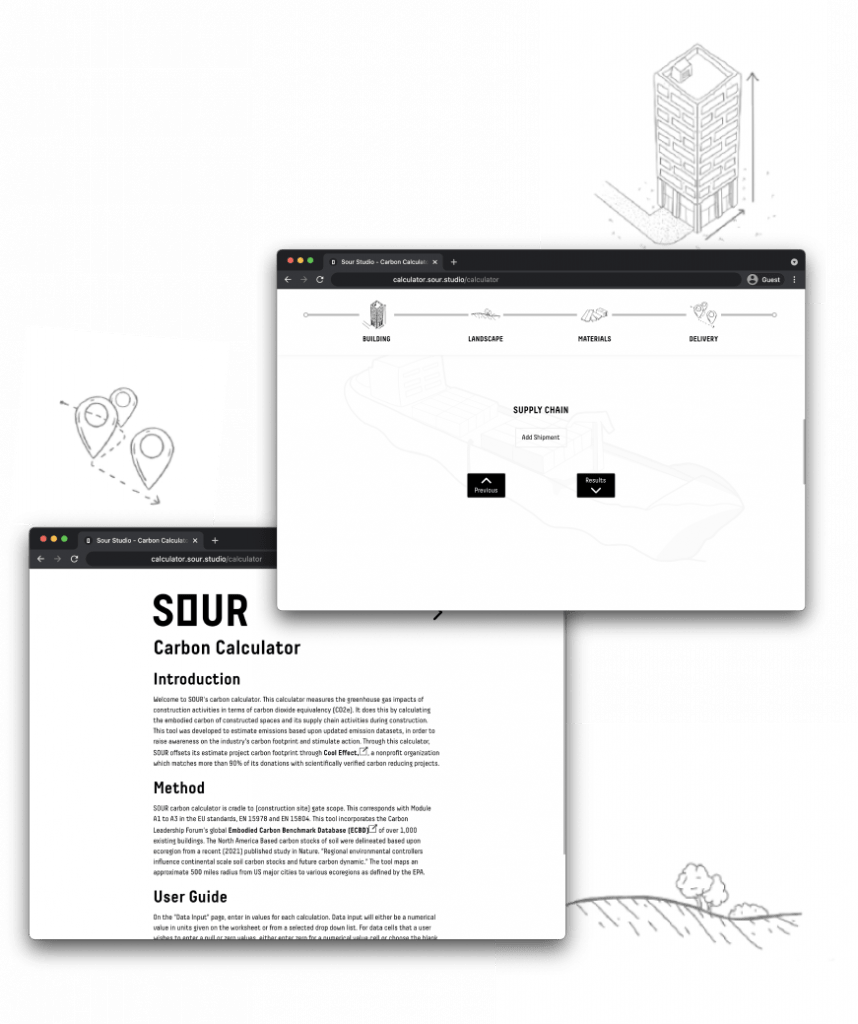In order to shine light on our growing climate crisis and the action we need to take, international architecture and design studio SOUR dedicated their Journal Issue 03 to the footprint created by architects, products, and our built environment.
By the team at SOUR. All images courtesy of SOUR.

Addressing the biggest polluting industry, SOUR tries to raise awareness within the construction sector and beyond, through projects ranging from expert interviews and panel discussions, the creation of their Carbon Calculator, guidelines to untap the 15-Minute City, and a regenerative housing model built from local materials to minimize carbon emissions.
The frequent publishing of research and collaborations is in line with the studio’s mission to actively educate the end user and communicate sustainable developments to clients, as well as working with local communities, and empowering designers to think about alternatives to the standard concrete and steel materials. Because while the word, SOUR, is a play on their mission to address social and urban issues, the meaning describes their attitude: they don’t shy away from challenges. Like the process of sourdough making, SOUR takes its time: to research, synthesize and ideate – in order to generate data-inspired and purposeful design solutions.
You can read more about SOUR on their website sour.studio, and find the Journal Issue 03 under the research tab or through this link. To give you a piece of the cake, here is the introduction of this issue of the Journal:
Architects As Sustainable Actionists
If you are at all concerned about the health of this planet we live on together, or concerned about what we can do as a species to survive and thrive on this big, beautiful ball, then you are probably trying your best to minimize your impact on the environment. Maybe you recycle religiously, eat locally-sourced produce, avoid factory farmed meat, drive an electric car, bike to work, or shun fast fashion. You are consciously aware of your carbon footprint. You make your feet tiny, like a baby. These are the things we must do to ensure that our kids…and their kids…and their kids…will be around to enjoy the magic of a sunset or the undulating beauty of a school of fish.
But there’s more weight behind the surface machinations of sustainability than we may realize, and our footprints sink deeper and spread wider due to a range of factors that many of us never realize. How far did that veggie burger travel before you bought it, plastic-wrapped, from the shelf of your local supermarket? How much of that plastic is actually recyclable? What’s the shelf life of the battery in that electric car?
All these factors underlie and complicate the initially simple idea of living simply. The operational costs of being human—the consuming— are often front-and-center. But what’s not normally considered is everything surrounding that.

The same is true of our built environment. A building’s carbon footprint is the total amount of CO2 it emits throughout its lifespan, from construction, operation, and eventually demolition. Much policy and publicity revolve around the operational features that can make buildings more efficient. Solar panels, water circulation/filtration, insulation/ shading, and green roofs are all well-documented methods of reducing a building’s carbon footprint over the course of its operation. These all deal mainly with heating, cooling, powering, and providing water.
What isn’t so well documented or discussed is the footprint of the embodied carbon—the energy and emissions involved in everything from extracting, processing, and transporting materials, to the construction of the building and machinery used, down to the deconstruction at the end. Depending on the type of building, these embodied carbon emissions can account for 30-70 % of a building’s lifetime carbon footprint.

At SOUR, we’ve been searching for ways to incorporate a whole-systems approach into our design solutions. This starts before the initial design, even. By communicating sustainable development to clients, working with local communities, and empowering designers to think about alternatives to the standard concrete and steel materials, we can move decisively from the very beginning towards this goal.
So much of what we do in the initial design phase will impact the construction, operation, maintenance, and eventual demolition of a building. Accounting for the set and setting of a structure is a huge part of this. Encouraging the use of locally-sourced, recycled materials not only cuts down on transportation costs and its associated CO2 emissions, but it also primes a building for more efficient operation/repairs, and will allow many of its components to be reused after its been demolished, contributing towards a circular economy.

When we zoom out, we can apply these concepts to how we design our cities. For “15-Minute City”, a design competition hosted by The Charrete, we collaborated with Buro Happold and proposed “The Untapped City”, which reimagines how we can adapt and tailor the needs and environments of each individual neighborhood in order to create cities where everything a resident needs is no more than 15 minutes away by foot, bike, or public transit. To do this effectively, we must understand the context of the space, involve the community, and develop specific interventions that draw on local materials and ease specific pressure points.
The 15-Minute City proposal is informed by cross-disciplinary outreach across fields ranging from environmental psychology to circular economics to supply chains to engineering. In order to design better, more sustainable, more inclusive, healthier, and accessible spaces, we must research and collaborate, which is the impetus behind our www/ project. And we’re excited to have recently participated in Wastebuild Everywhere, where we held a panel discussion about what’s wrong with supply chains. Panelists discussed the underlying reasons for problems in supply chains, how demand can be the bridge between supply chains and a circular economy, and contributed their expertise in fields as diverse as food waste, fashion, single-use plastic and electronics.

We were also pleased to unveil our Carbon Calculator this summer, which has synthesized a lot of our research and discussions into a tool that tracks the greenhouse gas impacts of construction activities connected to a prospective project. This calculator will allow us to raise awareness about the impact of embodied carbon within the industry and hopefully lead to more informed construction practices and material sourcing.
So let’s continue to keep our feet light and our operational costs low. But let’s also expand our perspectives and keep our eyes wide to the complexities and entanglements of our modern moment, and understand that it will take a collective effort if we want to create truly sustainable development.